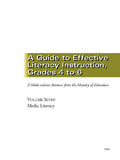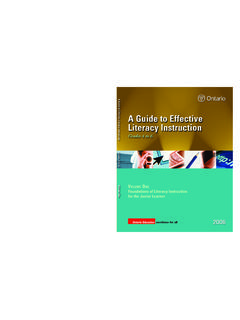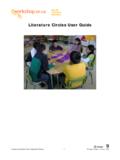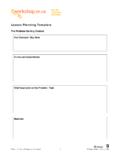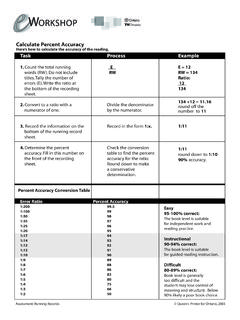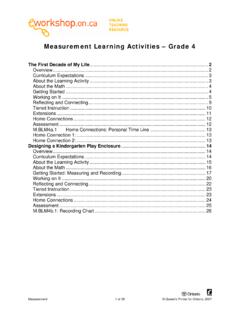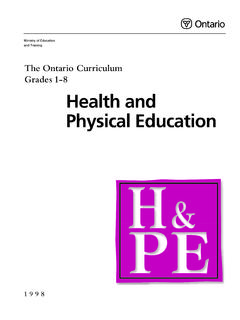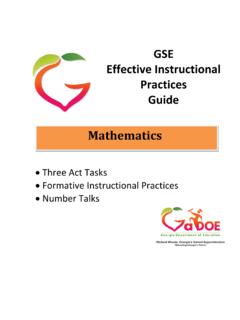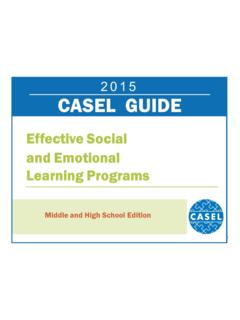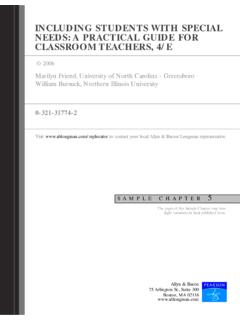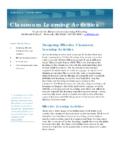Transcription of A Guide to Effective Literacy Instruction, - eWorkshop
1 A Guide to Effective Literacy Instruction, Grades 4 to 6 Volume One: Foundations of Literacy Instruction for the Junior Learner1. The Junior Learner2. Knowledge and Skills Required for Literacy3. Principles of Effective Literacy InstructionVolume Two: AssessmentVolume Three: Planning and Classroom Management1. Planning2. Classroom Environment and ResourcesThe subsequent volumes in the series will cover a range of topics, including instructional approaches in oral communication, reading, writing, and media Literacy , and technology as it supports instruction and Guide to EffectiveLiteracy Instruction, Grades 4 to 6A Guide to EffectiveLiteracy Instruction, Grades 4 to 6A Multivolume Resource from the Ministry of EducationVOLUMETHREEP lanning and Classroom Management 1 Diversity and Effective Instruction .. 1 Planning Language Programs for Students With Special Educational Needs .. 9 CHAPTER1: 11 Introduction .. 13 Planning for Literacy Instruction.
2 13 Planning for Integrated Literacy Learning Across the Curriculum .. 17 Teamwork for Literacy Planning .. 19 Signature Page: Michael 21 The Literacy Assessment, Planning, and Instruction Cycle .. 22 Types of Plans .. 23 Long-Range Planning .. 25 Short-Term or Unit Planning .. 28 Lesson Planning .. 39 Timetabling for the Junior Classroom .. 45 Appendices .. 51 CHAPTER2: CLASSROOMENVIRONMENT 63 Classroom Environment .. 64 Resources .. 74 STUDENTRESOURCESCITED 89 REFERENCES 93 CONTENTSUne s rie de publications quivalente est disponible en fran ais sous le titre suivant : Guide d enseignement efficace en mati re de litt ratie de la 4e la 6eann Guide to Effective Literacy Instruction, Grades 4 to 6is organized into several first three volumes provide the foundation for Effective Literacy instruction and Literacy learning in the junior grades. Subsequent volumes go more deeply into what to teach and how in order to help all students experience 3, Planning and Classroom Management ,focuses on planning for literacyinstruction and on the classroom environment and resources.
3 Chapter 1 describes planningapproaches and types of plans, and provides a detailed discussion of the processes andtools that can be used in long-range, short-term, and lesson planning. Chapter 2 describeshow the classroom environment can be organized to make the most of the resourcesavailable, examines various types of texts appropriate for different aspects of literacyinstruction, and discusses considerations involved in selecting texts for students withdifferent backgrounds, abilities, and each volume in this series, teachers are reminded of the key messages, listed in thechart on page 2, that are intended to help them address the goals of the junior literacyprogram. The key messages are fundamental ideas that underlie all of the approaches,strategies, and tools described in this Guide . They answer the question, Why am I teachingthis material, in this way, to this group of students, at this time? Teachers can use thesekey messages to Guide their and Effective InstructionA Vision for Equity in Ontario ClassroomsSchool classrooms represent the world in miniature; they mirror our larger society.
4 The diversity that exists in our classrooms has helped to shape our vision for educationin Ontario today. All children, regardless of their background and/or ability, deserveopportunities to learn and to grow, both cognitively and socially. The challenge is toreach more children more effectively. To do this, we need to create a vision for learning thatmakes every child feel develop the right learning conditions for each individual child, we must allow for avariety of cultural experiences and multiple perspectives, so that all children feel valuedin the Guide TO Effective Literacy INSTRUCTION, GRADES 4 TO 6 VOLUME THREE2 Key Messages for Teachers and StudentsEffective Literacy teachers in Grades 4 to 6understand that: Literacy instruction must be driven by equitableongoing instruction must be explicit and relevantto students instruction must be differentiated, inclusive, and respectful of all unique identities and diverse experi-ences can contribute greatly to a rich is the foundation for , writing, talking, listening, thinking, viewing,and representing are reciprocal Literacy need to become proficient in multiliteracies , involving texts of all need to learn that their Literacy skills are transferable to all content learn best when they are motivated and actively engaged in their learning.
5 Explicit feedback given immediately after assessment leads to improved levels of gradually releasing responsibility for learningto students, teachers help students improve their learning and develop a greater level of students are encouraged to assess theirown work and set their own goals, they take ownership of their Literacy experiences help studentsdevelop skills and attitudes that will serve themthroughout their lives and improve the quality oftheir skills give students a growingawareness of themselves as learners and a greaterdegree of and critical- Literacy skills are the tools students need in order to develop into active, responsible participants in the global collaboration and ongoing learninghelp teachers develop a deeper, broader, morereflective understanding of Effective students in Grades 4 to 6 understand that:Assessments are a way for the teacher and forme to understand how well I am learn best when I am reading and writing for a real tasks will be difficult, but I can learn thestrategies that I need to have valuable knowledge and experiences that I can share with my talk helps me to improve my reading,writing, and will make me a better writer, and writingwill make me a better reader.
6 Talking, listening, andthinking will make me a better reader and need to use my Literacy skills to work with textsof all can apply the strategies and skills that I learn in Language to all I am actively involved in making meaning when I readand write, I will improve my teacher s feedback will help me to improvemy strategies I am learning will help me becomea proficient and independent reader, writer, need to think about my learning and set goals for my how to read, write, and communicateeffectively will help me be successful during myschool years and throughout my about my thinking will help me understandwhat I have learned, make decisions about mylearning,and become a more independent need to think critically about all the texts Iencounter, and ask myself questions about theaccuracy and fairness of the stories or informationin these with others gives me new ideas andhelps me to reflect on and expand my own thinkingand , Equity, and Student AchievementEffective learning environments are those that consistently foster student performance of all students is strengthened when the diversity of the class is recognized and students different backgrounds and experiences is best accomplishedby weaving appropriate examples throughout lessons in all subject areas.
7 Learningoccurs when students are exposed to the unfamiliar. Discussing viewpoints and sharingaspects of different cultures, customs, and languages are powerful tools for committed to inclusion means empowering students to use their voices andexperiences in building their knowledge and understanding. The diversity of students voices must be reflected in learning materials, discussions, problem solving, and learningapplications. Teachers who recognize and build on the diversity of their students adoptflexible approaches, maintain high standards, and bring concepts alive by presentingthem in contexts that students perceive to be real and instance, in developing a social studies unit on early settlers in Upper Canada(Grade 3), or a history unit on the development of Western Canada (Grade 8), teachersneed to ensure that stories of pioneers who established Black communities, such asDresden and Buxton in Ontario, or Breton, Wildwood, Maidstone, and Campsie inAlberta and Saskatchewan, are included in the readings and pictures they choose forstudents.
8 Similarly, in science programs, the achievements of scientists and inventorswho are women or who come from Aboriginal, Black, or other minority backgroundsmust be celebrated. Pictures and examples should illustrate the accomplishments of allmembers of society, so that children will see themselves in the open to students diverse experiences and points of view increases opportunitiesfor teachers to seize teachable moments that support Effective Literacy is closely linked to culture. The texts that children see, use, and create in the junior grades send a strong message about the culture of learning in their school and in Ontario. Students who see themselves reflected and affirmed in classroom texts and in instruction (that is, those who experience language, culture, and identity engagement)come to appreciate that reading and writing are genuinely forthem and aboutthem. In addition to having their own identity affirmed in this way, junior students learn aboutthe cultures and identities of others in the classroom and in the community, and begin to appreciate the richness and diversity of Canadian society.
9 From this firm foundation,students learn to live with respect and intellectual vigour in a multicultural world, andthey build the higher-order thinking and critical- Literacy skills they need for responsiblecitizenship and lifelong learning in the twenty-first century. ( Literacy for Learning, 2004, p. 6)Supporting Diverse Learning StylesStudent self-esteem is fostered through the creation of competencies. Helping studentsto develop competencies empowers them and creates an intrinsicmotivation to in supporting student learning depends, in part, on taking into account thediversity of learning styles among students in the classroom. There are many differenttheories about learning styles that highlight the restrictions of conventional thinkingabout learning and that help teachers respond more effectively to the diverse learningstyles of their students. Howard Gardner s theory of multiple intelligences is one example. Multiple intelligences , as identified by Gardner, reflect the following waysof demonstrating intellectual ability: Interpersonal, Intrapersonal, Verbal/Linguistic,Logical/Mathematical, Musical/Rhythmic, Visual/Spatial, Bodily/Kinesthetic, andNaturalist.
10 When teachers take these intelligences into account in their lesson designand their assessment of student achievement, they can focus on a range of studentstrengths that reflects the varied abilities of the class as a an Environment Conducive to LearningAn environment that helps promote learning is critical to engaging students in school-work and class activities. Learning is a social activity. However, the ways in which students respond to the social environment in the classroom may vary considerably. For some students, the environment may be as integral to learning as the actual learningactivities in which they participate. When students are comfortable and feel secure intheir learning environment, their true potential will be reflected in their and valuing diversity strengthens students capacity to work both independ-entlyand within a collaborative Diversity in Its Many FormsDiversity takes many forms and exists in all Ontario communities.


